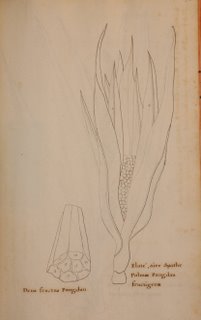josef george kamel, s.j. drawing of pandan flower and fruit


Pandan [Pandanus tectoris] The pandanus or pandan illustrated by Kamel is most likely Pandanus tectoris. There are many pandan species, about 800 trees and shrubs, belonging to the screw pine family like Pandanus odorus, P. latifolius, P. utilissimus, P. odorantissimus and Pandanus amaryllifolius Roxb. The last cited species is a small shrub whose leaves are used as a mild spice to flavor water, rice and other dishes. A refreshing tea can also be made from P. amaryllifolius leaves.
P. amaryllifolius is largely cultivated and an extensive wild population is unknown.
While P. amaryllifolius is associated with cuisine, Pandanus tectorius or screwpine is a useful tree since its leaves are used for weaving mats, baskets, hats, fans and, in the past, sails for the outrigger boats like the barangay and paraw.
The multi-branched tree grows well to a height of about 8 meters on sandy or rocky shores, where it serves as a windbreak. The tree has aerial roots. Leaves are M-shaped in cross section and notorious for the fine thorns that line its margins and midrib. Flowers are dimorphic: white male flowers have large white bracts while females appear in a head. Both appear at branch tips. The flowers develop into a globular shape, with separate pieces or phalanges that mature to form a deep green color to a orange brown fruit. Kamel illustrates the pandan flower cluster and a portion of the fruit.
Uses: While the fruit has an edible core beneath the fibrous husk, it is hardly eaten in the Philippines and left to mature and fall, whence it becomes animal fodder. Pandan, however, is cultivated because its leaves are used for weaving and may even be found in inshore areas as ornamentals or as barriers because of its thorny leaf. Cultivars of the pandan are available commercially as landscaping material. The dwarf and the varigated varieties are popular.

0 Comments:
Post a Comment
<< Home